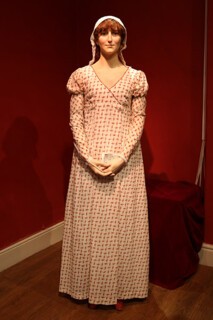Waxen Jane
Alice Spawls
It would be hard to draw a picture of one of Austen’s characters based on the books: the narrators offer little physical description at all (‘plain’, ‘tall’) and the other characters don’t go much further than ‘fair’ and ‘dark-eyed’ (how-much-a-year is far more significant). But Austen does tell us a lot about the way the valuation of appearance betrays prejudices. Bingley’s ardency is evident from his first sight of Jane – ‘Oh! she is the most beautiful creature I ever beheld!’ – and Elizabeth is as firm in her loyalty: ‘You were about five times as pretty as every other woman in the room.' Darcy considers Elizabeth ‘barely tolerable’ to begin with, but by the end declares her ‘one of the handsomest women of my acquaintance’. Elizabeth is surprised to find Darcy’s sister unintimidating; her gentleness is apparent in her ‘womanly and graceful’ appearance. Before she’s even aware of her feelings for him, Lizzy decides her competitor for Darcy’s affections, Lady Anne, is ‘sickly and cross’, while Caroline Bingley, who’s also after him, insists that Lizzy is ‘no beauty’. Lydia, who wants to grow up quickly, says: ‘Though I am the youngest, I’m the tallest.’ As for Darcy, Bingley says he’s tall, Kitty says he’s tall, Mrs Bennet says he’s tall, and for most of the novel that’s the only positive thing anyone can say about him. The earlier goodwill towards him, which prompts this description, has its root neatly exposed:
Mr Darcy soon drew the attention of the room by his fine, tall person, handsome features, noble mien; and the report which was in general circulation within five minutes after his entrance, of his having ten thousand a year.
What would Austen have to say about the obsession with her own appearance? The Jane Austen Centre in Bath has just unveiled a waxwork they claim is ‘pretty much like her’. It’s hard to tell: the only portrait that shows her face (said to be by her sister Cassandra) is disputed; the image that will feature on the £10 note is certainly a long way off. Melissa Dring, the forensic artist employed to recreate her face, wasn’t impressed with Cassandra’s sketch – ‘like she's been sucking lemons’ – so she came up with her own likeness, based on contemporary descriptions: long nose, brown eyes, curly brown hair. It’s not quite enough to make a waxwork out of and the contemporary descriptions are not as useful as they might seem. Was her face round or long? Her niece thought it might be more round. Complexion? ‘Clear... not pink’. The account by her nephew, James Edward Austen-Leigh, who was keen to profit from his memoir of sweet Aunt Jane (he was the first to soften her image), should probably be taken with a pinch of salt:
Her figure was rather tall and slender, her step light and firm, and her whole appearance expressive of health and animation. In complexion she was a clear brunette with a rich colour; she had full round cheeks, with mouth and nose small and well-formed, bright hazel eyes, and brown hair forming natural curls close round her face.
The waxwork is tall (5’7”) and has brown hair (though not dark, as Caroline Austen has it), a long nose and small mouth. But somehow it doesn’t add up to a whole: with each new manifestation Austen looks less and less like a real person. Dring wanted to show how ‘mischievous' and ‘witty’ she was: the waxen Jane looks more like she she’s posing for a picture she doesn’t want to be in. The closest ‘anyone has come to the real Jane Austen for 200 years’? Only if you haven’t read the books.
